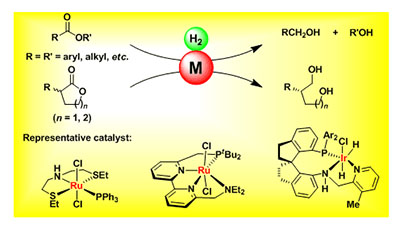摘要/Abstract

酯的均相催化氢化是合成醇的重要方法,在精细化学品生产中有重要用途.用氢气还原酯是绿色、原子经济和可持续的化学转化方法.尽管仍然存在巨大的挑战,酯的均相催化氢化研究在过去十年里取得了令人瞩目的进展,出现了许多过渡金属催化剂,其中包括钌、锇、铱等贵金属催化剂,以及铁、钴和锰等丰产金属催化剂.金属催化剂中的配体也得到了极大的拓展,出现了包括二乙胺和吡啶等为骨架的系列三齿钳形配体,具有联吡啶和吡啶骨架的四齿配体,以及双胺、胺基膦、吡啶胺和胺卡宾等类型的双齿配体.酯均相催化氢化的效率也得到了显著的提高,催化氢化乙酸乙酯和苯甲酸乙酯等标准底物的转化数最高可达到90000.酯的不对称催化氢化合成手性伯醇也取得了突破,酮酸酯、消旋δ-羟基酯和α-芳基/烷基取代内酯的不对称催化氢化为光学活性手性二醇的合成提供了高效新方法.本论文主要从酯氢化中配体和催化剂的发展以及酯的不对称催化氢化两个方面综述酯的均相催化氢化近年来所取得的研究进展.
关键词: 酯, 氢化, 醇, 均相催化, 催化剂
The reduction of esters to alcohols is one of the most important chemical transformations in the production of fine chemicals, such as pharmaceuticals, agricultural chemicals, fragrances, and biofuels. Homogeneous catalytic hydrogenation of esters represents a green, atom-economic, and sustainable alternative to conventional stoichiometric approaches, avoiding the generation of large amount of wastes and the difficulties arose in work-up procedure by using metal hydride reductants. Although challenges still exist, significant progress has been made in catalytic hydrogenation of esters over the last ten years. Numerous transition metal catalysts including noble metal (such as ruthenium, osmium, and iridium) complexes and base metal catalysts (such as iron, cobalt, and manganese) have been developed for the hydrogenation of esters. The ligands of the catalysts have been well studied. A wide range of bidentate ligands including diamines, amino-phosphines, pyridine-amines, N-heterocyclic carbene-amines, and bipyridines, tridentate pincer ligands containing diethylamine and pyridine skeletons, tetradentate ligands containing pyridine and bipyridine skeletons have been applied in the hydrogenation of esters. The efficiency of hydrogenation of esters has been significantly improved, and the highest turnover number (TON) reached 90000 for the hydrogenation of benchmark substrates such as ethyl acetate, ethyl benzoate, and γ-valerolactone. A significant breakthrough has also been made in the catalytic asymmetric hydrogenation of esters to chiral primary alcohols. The asymmetric hydrogenations of ketoesters, racemic δ-hydroxyesters, and racemic α-aryl/alkyl substituted lactones provided efficient methods for the asymmetric synthesis of optically active chiral diols including chiral 1,5-diols and 1,4-diols. The significant progress achieved in recent years in the area of homogeneous catalytic hydrogenation of esters to alcohols is presented in this review. The focus of this review are the development of ligands and catalysts, and the advances in the catalytic asymmetric hydrogenation of esters and lactones.
Key words: ester, hydrogenation, alcohol, homogeneous catalysis, catalyst
PDF全文下载地址:
点我下载PDF
